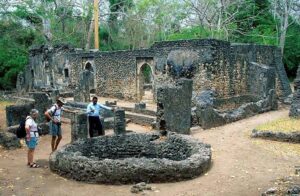Nestled amidst the lush coastal forests of Kenya lies a hidden gem steeped in mystery and history – the Gedi Ruins. This archaeological site, shrouded in intrigue, offers a captivating glimpse into the past of a thriving Swahili settlement. From its enigmatic ruins to its rich cultural heritage, Gedi beckons adventurers and history enthusiasts alike to uncover its secrets. In this article, we delve into the allure of Gedi Ruins and why it stands as a must-visit destination for travelers exploring Kenya’s coastal region.
Discovering Gedi Ruins: A Historical Overview
Gedi, located about 65 kilometers north of Mombasa, was once a bustling Swahili town flourishing between the 13th and 17th centuries. It served as a vibrant hub for trade, culture, and Islamic scholarship along the East African coast. The town’s strategic location facilitated commerce with traders from Arabia, India, and beyond, enriching its cultural tapestry. However, the reasons for its eventual abandonment remain a subject of speculation, adding to its mystique.

Exploring the Archaeological Site
Visitors to Gedi Ruins are greeted by a captivating landscape of ancient stone structures intertwined with the surrounding vegetation. The ruins include a mosque, houses, tombs, and a palace, providing a fascinating glimpse into the daily lives of its inhabitants centuries ago. As you wander through the labyrinthine pathways, imagine the bustling marketplace, echoing prayers, and vibrant community that once thrived within these walls. Intricately carved Swahili inscriptions and architectural details offer clues to the town’s cultural heritage and religious practices.
The Lore of Gedi: Tales of Mystery and Intrigue
Embedded within the lush foliage surrounding Gedi Ruins are whispers of eerie legends and ghostly encounters, passed down through generations by local inhabitants. These tales weave a tapestry of mystery and intrigue, adding an extra layer of fascination to the ancient site. According to local lore, the ruins are said to be haunted by restless spirits, their ethereal presence felt among the weathered stone structures, especially under the cloak of night. Visitors often recount spine-chilling experiences of inexplicable sounds echoing through the ruins or fleeting glimpses of shadowy figures darting among the trees. While skeptics may dismiss these stories as mere superstition, the palpable atmosphere of Gedi Ruins lends credence to the possibility that the spirits of the past still linger, guarding their secrets from prying eyes. Whether one believes in the supernatural or not, the haunting tales of Gedi add a fascinating dimension to the site’s enigmatic allure, inviting visitors to ponder the mysteries that lie beneath its ancient stones.
Unraveling the Mysteries
One of the most intriguing aspects of Gedi Ruins is the mystery surrounding its decline and eventual abandonment. Historians and archaeologists continue to debate the reasons behind the town’s demise, with theories ranging from environmental factors to political upheaval. The enigmatic atmosphere of Gedi invites visitors to ponder its past and contemplate the forces that shaped its destiny. Despite centuries of erosion and decay, the ruins retain an aura of resilience and intrigue, captivating the imagination of all who explore them.
Also, read; Kenya Waives Visa Registration Fee for Six African Nations

Cultural Significance
Beyond its archaeological importance, Gedi Ruins hold significant cultural value for the Swahili people and Kenya as a whole. The site serves as a symbol of resilience and heritage, reminding visitors of the rich tapestry of cultures that have shaped the region over centuries. Through preservation efforts and cultural tourism initiatives, Gedi continues to inspire a sense of pride and connection among local communities. Traditional Swahili customs and rituals are celebrated through cultural events and performances, providing visitors with an immersive experience of the region’s vibrant heritage.
Ecotourism and Conservation
In addition to its historical and cultural significance, Gedi Ruins offer opportunities for eco-conscious travelers to explore the surrounding coastal forest ecosystem. Guided nature walks provide insight into the region’s biodiversity, with the chance to spot indigenous flora and fauna. Sustainable tourism practices are crucial for preserving both the archaeological site and its natural surroundings for future generations to enjoy. By promoting conservation efforts and responsible tourism practices, Gedi Ruins serve as a model for sustainable heritage tourism in Kenya.

Visiting Gedi Ruins: Practical Information
For travelers planning a visit to Gedi Ruins, it is recommended to allocate sufficient time to explore the site thoroughly. Guided tours are available, offering informative insights into the history and significance of the ruins. Additionally, visitors should come prepared with comfortable walking shoes, sunscreen, and plenty of water, especially during the warmer months. Nearby accommodations and dining options provide convenient amenities for travelers looking to extend their stay and immerse themselves in the beauty and history of the region.
 Conclusion
Conclusion
In conclusion, Gedi Ruins stand as a testament to Kenya’s rich historical and cultural heritage. From its ancient stone structures to the mysteries that shroud its past, Gedi invites visitors on a journey through time and imagination. Whether you’re a history enthusiast, nature lover, or cultural explorer, a visit to Gedi Ruins promises an unforgettable experience that will leave a lasting impression.
